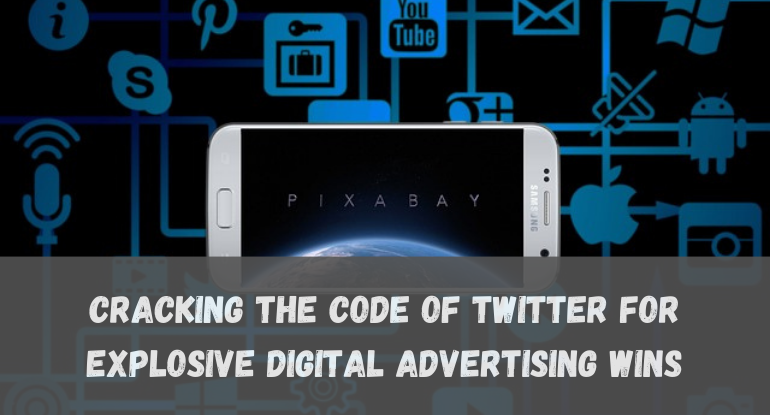This blog post is a guide to harnessing Twitter’s potential in digital advertising. We’ll dissect strategies and best practices for creating compelling ad campaigns, boosting engagement, and optimizing overall performance.
Explore the transformation of tweets into captivating ads that truly resonate with audiences. Delve into the keys to fostering meaningful engagement, nurturing connections, and cultivating brand loyalty on this dynamic platform.
Uncover the art of optimization through analytics and real-time insights, understanding the pulse of Twitter’s landscape for effective advertising strategies.
Join us in navigating the intricacies of Twitter’s ecosystem, maximizing its power to drive successful digital campaigns and amplify your brand’s impact.
Introduction to Twitter Advertising

Twitter Advertising is a dynamic and influential platform that allows businesses, brands, and individuals to promote their products, services, or messages to a vast audience.
Utilising the power of Twitter’s extensive user base and engagement features, Twitter Advertising serves as a valuable tool for reaching specific demographics, increasing brand visibility, and driving desired actions.
Key Components of Twitter Advertising
#1. Promoted Tweets: These are standard tweets that businesses boost to expand their reach beyond their current followers. They show up in users’ timelines, search results, or in the feeds of specific users chosen through targeting criteria.
These tweets help amplify brand messages, promotions, or important announcements to a broader audience.
#2. Promoted Accounts: This feature aids in increasing a Twitter account’s followers by showcasing it to users who might be interested in the account’s content or brand. It’s an effective way to grow a relevant and engaged follower base by reaching out to users likely to engage with the account’s tweets.
#3. Promoted Trends: Twitter highlights popular and trending topics. Businesses can pay to promote their hashtag or topic among these trends, ensuring it gains widespread visibility and engagement.
This can create buzz around a campaign, event, or product launch, driving conversations and interactions.
#4. Targeting Options: Twitter’s advertising platform offers a wide array of precise targeting options. Advertisers can define their audience based on interests, demographics, location, behavior, and keywords.
This level of specificity allows businesses to tailor their campaigns to reach the most relevant audience, enhancing the effectiveness of their ads.
#5. Analytics and Insights: Twitter provides comprehensive analytics tools that enable advertisers to track and measure the performance of their campaigns. These insights include data on engagement metrics, audience demographics, reach, and more.
By analyzing these metrics, advertisers can gain valuable insights into what works best and optimize their strategies for better performance.
Advantages of Twitter Advertising

#1. Real-Time Engagement: Twitter’s real-time nature allows businesses to engage instantly with their audience. This immediacy is perfect for timely promotions, live events, breaking news, or time-sensitive announcements.
Brands can swiftly connect with their followers, fostering a sense of relevance and timeliness.
#2. Wide Reach and Viral Potential: Twitter boasts a vast global user base, offering immense potential for campaigns to gain traction and go viral. The platform’s quick sharing capabilities enable content to reach a massive audience rapidly.
Trending topics or hashtags can spark conversations worldwide, amplifying brand visibility significantly.
#3. Cost-Effective Options: Twitter’s advertising platform accommodates various budgeting options, making it accessible for businesses of all sizes.
From small startups to multinational corporations, advertisers can tailor their spending to their specific goals and financial capacities. This flexibility ensures that even modest budgets can yield impactful results.
#4. Engagement and Feedback: Twitter serves as a direct line of communication between brands and their audience. This direct engagement allows for quick feedback, facilitates customer service interactions, and encourages community engagement.
Brands can address concerns, respond to inquiries, and build strong relationships with their followers.
#5. Diverse Ad Formats: Twitter offers a diverse range of ad formats beyond simple text-based tweets. Advertisers can leverage multimedia content such as images, videos, GIFs, polls, and threads to captivate audiences.
This variety allows brands to convey messages more creatively, catering to different preferences and capturing attention effectively in the competitive digital space.
Effective Twitter Advertising Strategies
#1. Clear Objectives: Begin by setting clear and measurable goals for your advertising campaign on Twitter.
Whether it’s about increasing brand awareness, driving traffic to your website, boosting sales, or achieving specific conversions, defining these objectives guides your entire strategy.
#2. Compelling Content: Craft content that captivates and resonates with your target audience while aligning with your campaign objectives.
Ensure it’s engaging, relevant, and adds value to your audience’s experience on Twitter. Visuals, compelling copy, and a consistent brand voice are crucial elements for success.
#3. Targeted Audience Segmentation: Leverage Twitter’s robust targeting options to reach the right audience. Segment your audience based on demographics, interests, behaviors, and keywords to ensure your ads are reaching the most relevant users.
This precision targeting increases the likelihood of engagement and conversions.
#4. Consistent Monitoring and Optimization: Regularly monitor your campaign’s performance metrics and analyze the data provided by Twitter’s analytics tools.
Use these insights to make informed decisions and optimize your ad campaigns. Adjust targeting, content, or budget allocation based on what the data reveals to maximize ROI and overall effectiveness.
#5. Engagement and Interaction: Foster a sense of community and trust by actively engaging with your audience. Respond to comments, retweet relevant content, and participate in conversations related to your industry or niche.
Building relationships and engaging authentically can lead to a loyal and engaged following, driving long-term success on the platform.
Crafting Effective Twitter Ad Campaigns
Crafting effective Twitter ad campaigns involves a strategic approach aimed at maximizing engagement, reach, and conversions. Here are essential steps to create impactful campaigns:
#1. Understanding Your Audience: Start by thoroughly understanding your target audience. Define their demographics, interests, behaviors, and preferences. Use this information to tailor your ad content to resonate with their needs and interests.
#2. Setting Clear Objectives: Establish specific and measurable goals for your Twitter ad campaign. Whether it’s boosting brand awareness, driving website traffic, increasing sales, or generating leads, clearly defining your objectives guides your campaign strategy.
#3. Compelling Ad Creative: Create visually appealing and compelling ad content that grabs attention and communicates your message effectively. Use captivating visuals, concise and engaging copy, and a strong call-to-action (CTA) to prompt user interaction.
#4. Utilizing Targeting Options: Take advantage of Twitter’s sophisticated targeting features. Narrow down your audience based on factors like demographics, interests, location, and behaviors to ensure your ads are reaching the most relevant users.
#5. Optimizing for Mobile: Given the prevalence of mobile usage on Twitter, ensure your ad content is optimized for mobile devices. Use responsive designs, clear imagery, and concise text that can be easily viewed and understood on smaller screens.
#6. A/B Testing: Experiment with different ad variations by conducting A/B tests. Test various elements like ad copy, visuals, CTAs, and targeting options to identify the most effective combinations that yield higher engagement and conversions.
#7. Regular Monitoring and Optimization: Continuously monitor your campaign performance using Twitter’s analytics tools. Analyze metrics such as impressions, clicks, conversions, and engagement rates. Based on these insights, make data-driven optimizations to improve ad performance.
#8. Consistent Engagement: Engage with your audience consistently by responding to comments, retweeting relevant content, and initiating conversations. Building a relationship with your audience fosters trust and encourages ongoing interaction.
#9. Budget Management: Manage your ad budget effectively by allocating resources to the best-performing ads and targeting options. Regularly review and adjust your budget allocation based on the ROI of different ad sets.
By following these steps and continuously refining your approach based on data and audience feedback, you can create effective Twitter ad campaigns that resonate with your audience and drive desired outcomes.
Maximizing Engagement and Reach
Maximizing engagement and reach on Twitter involves strategic tactics aimed at captivating your audience and expanding your content’s visibility. Here are key approaches to boost engagement and reach:
#1. Compelling Content Creation: Craft content that resonates with your audience’s interests and preferences. Use eye-catching visuals, concise yet impactful messaging, and compelling storytelling to grab attention. Mix up content formats like images, videos, GIFs, and polls to keep your feed dynamic.
#2. Consistent Posting Schedule: Maintain a regular posting schedule to keep your audience engaged and accustomed to your content. However, prioritize quality over quantity to ensure each tweet adds value and encourages interaction.
#3. Hashtag Strategy: Employ relevant and trending hashtags in your tweets to expand their visibility beyond your followers. Research popular and industry-specific hashtags to amplify your content’s reach and join conversations within your niche.
#4. Engagement Initiatives: Actively engage with your audience by responding promptly to comments, retweeting relevant content, and initiating conversations. Encourage interaction through contests, polls, or Q&A sessions to spark engagement and build a sense of community.
#5. Visual Appeal: Visual content tends to perform well on Twitter. Use high-quality images, videos, or infographics that are visually appealing and easily digestible. Ensure they are optimized for the platform and mobile devices.
#6. Live Events and Trends: Capitalize on live events, trending topics, or real-time conversations by participating with relevant content. Timely tweets related to current events or trending topics can increase your visibility as users actively engage with these discussions.
#7. Collaborations and Influencers: Collaborate with influencers or industry leaders to amplify your reach. Partnering with relevant influencers can expose your brand to their followers, expanding your audience reach and credibility.
#8. Twitter Ads: Utilize Twitter’s advertising options to target specific audiences and extend your reach beyond organic methods. Promoted tweets, accounts, or trends can significantly enhance visibility and engagement when used strategically.
#9. Data-Driven Optimization: Regularly analyze Twitter analytics to understand what content performs best. Use this data to refine your content strategy, focusing on the types of content, posting times, and engagement tactics that resonate most with your audience.
By employing these strategies and continually adapting based on audience behavior and platform trends, you can effectively maximize engagement and reach on Twitter, fostering a vibrant and engaged community around your brand or content.
Analyzing and Refining Twitter Ad Performance

Analyzing and refining Twitter ad performance involves a systematic process of evaluating campaign metrics, gaining insights, and making data-driven adjustments to optimize the effectiveness of your ads. Here’s a comprehensive approach:
#1. Define Key Performance Indicators (KPIs): Start by establishing specific KPIs aligned with your campaign objectives. These could include metrics like impressions, clicks, engagement rates, conversions, or return on ad spend (ROAS).
#2. Access Analytics Tools: Utilize Twitter’s analytics tools to access comprehensive data about your ad performance. Monitor metrics such as reach, impressions, engagement, click-through rates (CTR), conversion rates, and cost-per-engagement (CPE) provided by the platform.
#3. Measure Campaign Effectiveness: Evaluate the performance of individual ad sets or campaigns against your predefined KPIs. Identify which ads are performing well and which ones might need improvement by comparing their performance metrics.
#4. Audience Insights: Dive into audience insights to understand demographics, behaviors, and preferences of the users engaging with your ads. Use this data to refine your targeting strategy and create more relevant content for your audience segments.
#5. Optimization Strategies: Based on your analysis, make informed optimizations to improve ad performance. Adjust targeting parameters, refine ad copy, experiment with different visuals, or reallocate budgets to the best-performing ad sets.
#6. Budget Allocation: Allocate your ad budget strategically based on the performance of different ad sets or campaigns. Increase investment in high-performing ads and reallocate resources from underperforming ones to maximize ROI.
#7. Timeline Analysis: Analyze the timeline of ad performance to identify trends or patterns. Determine if certain days, times, or seasons yield better results and schedule your ads accordingly for maximum impact.
#8. Continuous Monitoring and Iteration: Ad performance isn’t static; it evolves over time. Continuously monitor your campaigns and make iterative changes based on real-time data and ongoing analysis to keep improving results.
#9. Documentation and Reporting: Keep detailed records of your findings, optimizations made, and the impact of those changes. Create regular reports summarizing the performance and insights gained, which can inform future strategies.
By following these steps and maintaining a data-driven approach, you can consistently refine and optimize your Twitter ad campaigns, ensuring they remain effective and aligned with your marketing goals.
Conclusion
In summary, mastering Twitter for digital advertising success revolves around constant adaptation, data-driven refinement, engaging your audience, creative experimentation, and setting clear objectives. By embracing these strategies, you can unlock the full potential of Twitter for explosive success in your digital advertising endeavors.






